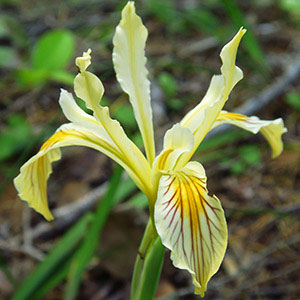Iris giganticaerulea
Iris bracteata
giant blue iris
Siskiyou iris
green, extensively branched, forming large clumps, 2–4 cm diam., with pale leaf scars.
sheathed with old leaf bases, slender, 0.6–0.9 cm diam.;
roots few, fibrous.
2–3-branched, solid, 10–15(–20+) dm.
simple, solid, 1.5–3 dm.
basal 4–6, erect, blade bright green, ensiform, 10–13 dm × 2–3 cm, apex slightly curved;
cauline with blade foliaceous, appearing as elongated spathe, 5–6.5 dm × 2–3 cm, not exceeding flowers.
basal with abaxial surface of blades deep glossy green on one side of fan, light yellow-green on other side, pink or red-tinged basally, strongly ribbed, 4–6 dm × 0.8–1 cm, rigid, margins not thickened;
cauline 3–6, imbricated, closely sheathing stem ca. 2/3 length, spreading distally, bractlike, blade inflated, often shorter than basal leaves.
2–3-flowered, branch units 1–2-flowered;
spathes tightly enclosing ovary and pedicel, 15–20 cm, subequal;
outer narrowly lanceolate, keeled, margins pale, narrow, inner margins translucent, broad, scarious.
simple, units 1–2-flowered;
spathes closed tightly around pedicel and ovary, lanceolate, 5.2–9 cm × 6–8 mm, subequal, herbaceous, margins scarious, apex acuminate.
perianth blue or blue-purple;
floral tube tubular-prismatic, 9-ribbed and -grooved, 4–5 cm;
sepals blue or blue-purple with white streaks surrounding signal, oval to orbicular-oval, 9.5–11 × 4–5 cm, base abruptly attenuate into claw, apex obtusely angled, signal with raised, yellow, pubescent central ridge, claw green, striate, 4–4.5 × 1–1.2 cm;
petals erect or spreading-erect, spatulate, 7–8.5 × 2–3 cm, base cuneate, apex emarginate;
ovary bluntly 6-angled, 4–4.5 cm;
style blue-violet, keeled, 3.5–4 cm, raised above sepals, crests recurved, 1.5–2 cm, margins sharply and irregularly serrate;
stigmas 2-lobed with 2 triangular teeth;
pedicel columnar, 3.5–5 cm.
perianth cream to buff-yellow;
floral tube 0.8–0.9 cm;
sepals with deeper yellow signal, veined with purple or brown, obovate-lanceolate, 6.5 × 2.5 cm, base gradually attenuate into wide claw;
petals narrowly oblanceolate, 7–9 × 0.8–2 cm, base gradually attenuate;
ovary nearly circular in cross section, 1.5–2.5 cm, base gradually attenuate into pedicel, apex abruptly acuminate into floral tube;
style 2.2–3 cm, crests spreading, yellow, not veined, 1.2 × 0.9–1.7 cm, margins toothed;
stigmas triangular or tongue-shaped, margins entire;
pedicel 3–6.2 cm.
drooping, bright green, ellipsoid, hexagonal in cross section, with 6 broad, rounded lobes, 8–10 × 3 cm, indehiscent;
after anthesis, flower stem elongates, arching downward to push capsule into water, where walls are broken down and as funiculus is broken, seed rises to surface.
nearly circular in cross section, tapering abruptly at each end, 2–2.5 × 1–1.5 cm.
in 2 rows per locule, brown, D-shaped, 8–10 mm wide, very corky.
dark brown, irregular in shape, wrinkled.
= 44.
= 40.
Iris giganticaerulea
Iris bracteata
Iris bracteata is limited to one county each in northern California and southern Oregon. It hybridizes with I. chrysophylla, I. douglasiana, I. innominata, I. munzii, I. purdyi, and I. tenax.
(Discussion copyrighted by Flora of North America; reprinted with permission.)


